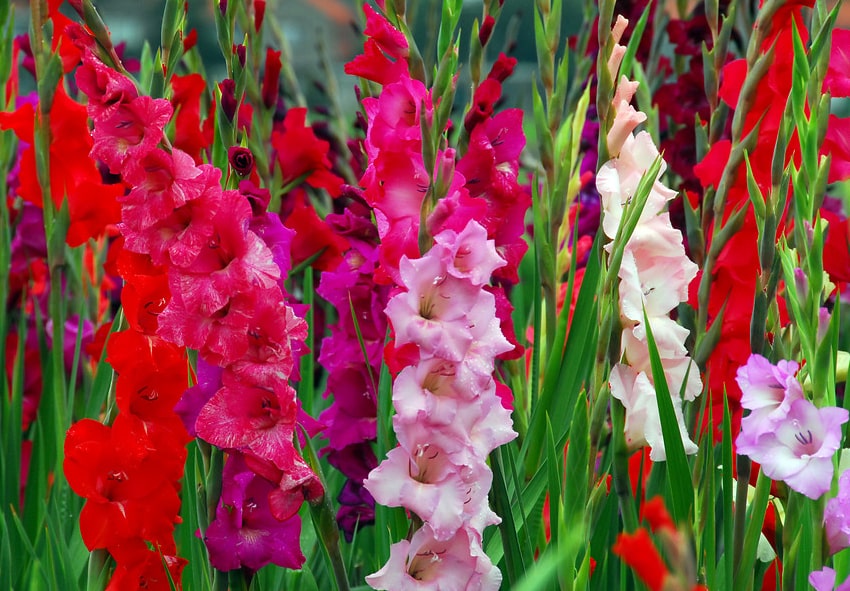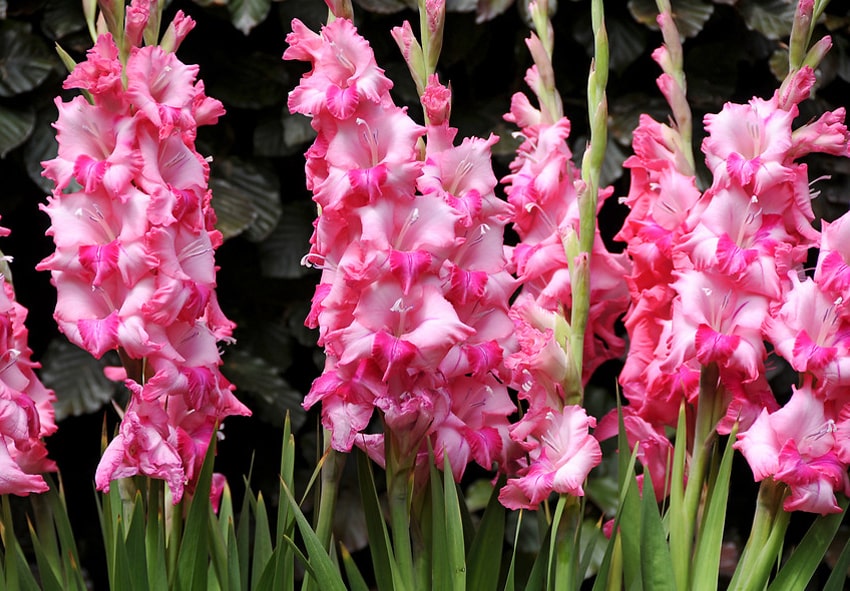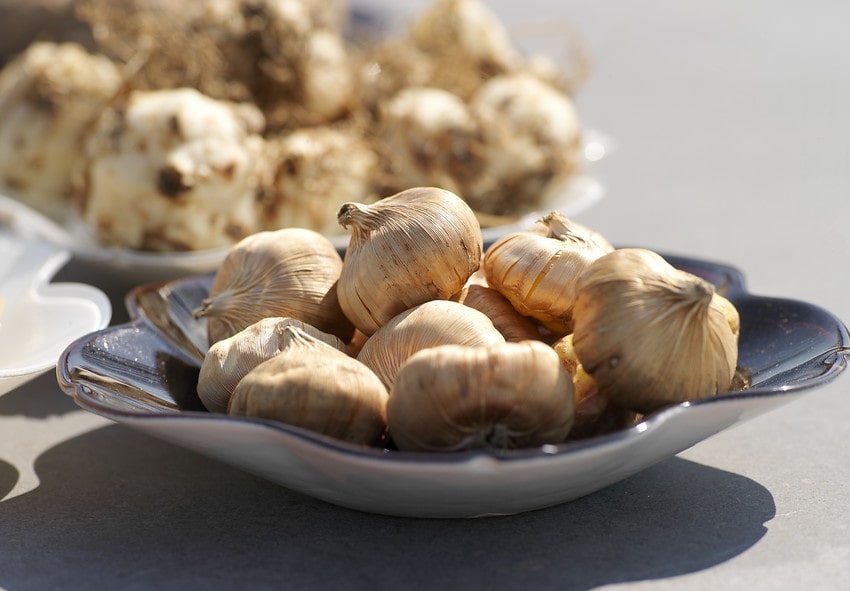Gladiolus has long been considered the flower of warriors. It is known from ancient chronicles that gladiators wore its corm in a hair gag on their chest as a talisman. And now, there is a belief that a gladiolus planted near the house will protect all household members from damage, the evil eye, misfortune, and wrongdoers.
When to plant gladioli bulbs in Ireland?
Planting gladiolus bulbs in the open ground should be carried out at different times in different regions of Ireland since climatic conditions vary significantly. Please note that the final planting dates are significantly affected by weather conditions. It is necessary to wait to plant such flowers in the soil until it warms up to 10 degrees Celsius at a depth of 12 centimetres.
Is it too late to plant gladiolus bulbs?

Experienced flower growers dig a hole and put an ordinary street thermometer in it to determine the appropriate planting date for the current year. It is not recommended to plant gladioli very early. In cold and wet soil, the bulbs will begin to rot. But you shouldn’t delay in planting gladiolus either: Flowering will be belated, and the flowers themselves will have to be watered more often and more abundantly.
The easiest and most accurate way to find out when to plant gladiolus bulbs is to ask local flower growers about it.
Location for planting
Plant your gladiolus in a sunny spot, sheltered from the wind, and they will show themselves in all their glory. In the southern regions, a light half-shade is acceptable: Sheltered from the scalding sun, gladioli will stand out in all their beauty longer in a flower bed. But you should not plant them in the same place for several years in a row — it is advisable to change the site annually.
Eliminate moisture stagnation, even short-term, and do not bring in fresh organic matter for planting. However, adding sand to the bottom of the planting hole can protect the corms from rot. Loose sandy or loamy soils with a slightly acidic reaction are ideal.
Planting in full sun in drained soil
It is not enough to choose the right gladioli planting dates to have a beautiful gladioli season, and even by a certain date. It also matters how the gladioli were planted and how the place was prepared.
Gladioli prefer sunny places and do not like stagnant moisture. How to grow gladioli? You need to monitor drainage and soil fertility. Ideally, a flower bed for planting these flowers should be prepared in advance: Mix equal parts fertile soil and sand. Sand should also be poured into the grooves under the bulbs in a layer of up to four centimetres. This will create additional drainage and protect the corms from rotting.
How deep to plant gladiolus bulbs

In addition to the timing of planting gladioli, the depth of the bulb affects the time it takes to flower. This is calculated based on the size of the planting material and the type of soil. So, on rich black and loamy soils, the corm should be at a depth of about 10 centimetres; on sandy soils, it is permissible to plant the corm at a depth of 14 centimetres. How deep to plant gladioli bulbs? The smaller the bulb, the less depth it needs.
The second crucial value is the distance between the bulbs. If they are planted too close together, then the plants will begin to compete with each other for nutrients, and this will affect the size of the flowers. For bulbs with a diameter of 4 centimetres, the optimal distance from each other is 20 centimetres. Small bulbs can be planted at a distance of 10–12 centimetres from each other.
How to plant gladiolus bulbs
To plant a gladiolus, it is necessary to make recesses based on the scheme:
- Trench: the distance between the bulbs is 15-20 centimetres, the gap between the trenches is 30-40 centimetres.
- Holes: the distance between the holes is 15-20 centimetres, and the distance between the rows is 25-30 centimetres.
It is recommended to pour sand at the bottom of the hole or trench, which will protect delicate roots and bulbs. It is enough to pour a layer of sand 2 centimetres thick. And after you place the planting material at the bottom, you need to pour a little sand on top again, and then the soil.
In pots
Gladioli feel great outdoors, so they can often be seen in gardens. But they also grow well in pots. A distinctive feature of these plants is the long flowering period. Therefore, they are great for decorating balconies, verandas, private houses, and flats.
In the Ground
Regardless of the number of buds, diameter, or colour, gladioli always look luxurious in a flower bed. Shades typically depend on the intensity of the light and the acidity of the soil. To prevent gladularia from becoming tasteless, do not use many different shades. For a flower bed of gladioli, combinations of two to four colours are suitable.
How to care for gladioli

Caring for gladioli is not hard. You just need to water the plants from time to time, gently loosen the soil around the bushes, and weed the area.
After planting, as soon as the height of the sprouts reaches 10–12 centimetres, mulch the base of the plant with tree bark, sawdust, humus, or straw. The layer of mulch should be about 5 centimetres thick.
Tall flowers provide support for growth and development.
Watering should be carried out in the morning or the evening, bringing water directly under the root every week. Moisture on flowers and buds can ruin their appearance.
Are gladioli perennial?
Gladiolus is a perennial bulbous crop. It belongs to the iris family. There are several thousand varieties of gladioli. The variety of shapes and beautiful colours is amazing. Although the flowers are very decorative, they also grow well in the wild. They can be found in Asia, South Africa, and some European countries.
Do gladiolus spread?
Gladiolus is propagated by corms, tubers, and seeds. Seeds are mainly used by breeders to grow new varieties.
Gladiolus height
The peduncle rises from the centre of closed leaves; its height can vary from 80 centimetres to 1.5 metres.
Read also Guide To Planting Dahlia Tubers.
Frequently Asked Questions (FAQs) about Planting Gladioli Bulbs
1. How deep should I plant Gladioli bulbs, and when is the best time to do so?
To plant Gladioli bulbs, dig a hole about 4-6 inches deep in well-draining soil. Plant the bulbs with the pointed end facing upwards, spacing them about 4-6 inches apart. The ideal time to plant Gladioli bulbs is in the spring after the last frost when the soil has warmed up. This will give them ample time to establish roots before flowering in the summer.
2. Can I plant Gladioli bulbs in pots or containers?
Yes, you can plant Gladioli bulbs in pots or containers. Use a well-draining potting mix and choose a container that is at least 12 inches deep. Follow the same planting guidelines as you would for the ground, and place the container in a sunny location. Container gardening allows you to enjoy Gladioli even if you have limited garden space.
3. What is the ideal location for planting Gladioli bulbs in my garden?
Gladioli thrive in full sun, so choose a spot in your garden that receives at least 6-8 hours of sunlight per day. Ensure the soil is well-draining to prevent bulb rot. If your soil is heavy or prone to waterlogging, consider adding organic matter or planting in raised beds to improve drainage.
4. Can I order Holland Gladioli bulbs from your online store, and when is the best time to purchase them?
Yes, you can order Gladioli bulbs from our online store. We typically offer a variety of Gladioli bulbs for purchase during the fall. Ordering in the fall allows you to receive your bulbs in time for spring planting, ensuring they have the best chance of thriving in your garden.
5. How do I care for Gladioli after planting?
After planting, water your Gladioli bulbs thoroughly to settle the soil around them. Water regularly, keeping the soil consistently moist but not waterlogged. As the plants grow, you may need to stake them to support their tall flower spikes. After they finish blooming, allow the foliage to wither naturally before cutting it back. You can lift and store Gladioli bulbs in a cool, dry place for the winter, or in milder climates, you may leave them in the ground with a layer of mulch for protection.
Published: 07.03.2022
